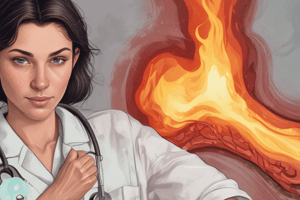Podcast
Questions and Answers
What is the recommended treatment for potential carbon monoxide (CO) exposure?
What is the recommended treatment for potential carbon monoxide (CO) exposure?
- Use a burn chart to evaluate BSA
- Provide 100% oxygen (correct)
- Apply ice to the affected area
- Administer nebulized epinephrine
Which type of burns are considered critical based on the percentage of body surface area (BSA) affected and patient age?
Which type of burns are considered critical based on the percentage of body surface area (BSA) affected and patient age?
- Burns involving the face, hands, or feet regardless of BSA
- 3rd-degree burns affecting more than 5% BSA
- 2nd and 3rd-degree burns affecting more than 20% BSA in patients over age 10 (correct)
- Burns with associated major traumatic injury
Why is applying ice or cooling not recommended for burns involving more than 10% of the body surface area?
Why is applying ice or cooling not recommended for burns involving more than 10% of the body surface area?
- To reduce pain
- To limit fluid loss
- To prevent infection
- To avoid hypothermia (correct)
In which scenario is transport to a trauma center not required for burn patients?
In which scenario is transport to a trauma center not required for burn patients?
Why are circumferential burns to extremities considered dangerous?
Why are circumferential burns to extremities considered dangerous?
When should nebulized epinephrine be considered for burn patients?
When should nebulized epinephrine be considered for burn patients?
What is the formula for calculating the amount of isotonic crystalloid to be infused over the first hour for a Total Body Surface Area (TBSA) of 30% in adults?
What is the formula for calculating the amount of isotonic crystalloid to be infused over the first hour for a Total Body Surface Area (TBSA) of 30% in adults?
For a patient weighing 105 kg with a TBSA of 40%, how many drops per minute (10 gtts) are required according to the Rule of 10s?
For a patient weighing 105 kg with a TBSA of 40%, how many drops per minute (10 gtts) are required according to the Rule of 10s?
In adults, what is the appropriate first-hour volume of isotonic crystalloid for a TBSA of 80%?
In adults, what is the appropriate first-hour volume of isotonic crystalloid for a TBSA of 80%?
What is the estimated TBSA percentage for a patient weighing 95 kg (~209 lbs) according to the given formula?
What is the estimated TBSA percentage for a patient weighing 95 kg (~209 lbs) according to the given formula?
Which TBSA percentage would require infusing 117 mL of isotonic crystalloid over the first hour in adults?
Which TBSA percentage would require infusing 117 mL of isotonic crystalloid over the first hour in adults?
For a TBSA of 50% in adults, how many milliliters (mL) of isotonic crystalloid should be infused over the first hour?
For a TBSA of 50% in adults, how many milliliters (mL) of isotonic crystalloid should be infused over the first hour?
According to the Rule of 10s, how many milliliters per hour (mL/hr) should be given for a TBSA of 90% in adults?
According to the Rule of 10s, how many milliliters per hour (mL/hr) should be given for a TBSA of 90% in adults?




